Preventing Caisson Damage to Gas Export Line - Remedial Options
VerifiedAdded on 2022/08/26
|11
|2102
|34
Report
AI Summary
This report addresses the critical issue of caisson damage to gas export lines in offshore construction. It begins by outlining potential risks, including the consequences of such damage, emphasizing the need for preventive measures. The report then proposes several remedial options, such as enhanced installation of ROV solutions, installation of restraints to prevent caisson damage, and regular physical inspections. A technical note follows, detailing failure scenarios, risk statements, and mitigation strategies for the organization. The report includes tables outlining component failure scenarios, risk assessments, and cost analyses, including commercial asset costs. Recommendations are made to improve asset information, testing, and research and development. The report concludes with a call for consistent system monitoring and timely fault identification for effective risk management and cost savings. The report also provides references and appendices with supporting information.

Question 2
Remedial Options That Might Be Adopted To Mitigate or Prevent Caisson from Hitting and Damaging the
Gas Export Line
Introduction
Most subsea construction works involve risks to human resources such as injuries or death and the system as
well leading to serious losses since they are often installed in places that are rarely visible. Offshore
platforms such as the caisson may develop problems causing severe damages to facilities in the subsea
environment leading to costly downtime in the production circle, environmental issues and dent on
reputation. Companies must put in place proper mechanisms to diagnose the issues leading to malfunctioning
of the caisson that could make it hit and damage the gas export line since such accidents may cause
interruption in service delivery, high cost of repair and sadly, causing danger to crew members and the public
(Cejuela,et al., 2018). Damage to a gas export line may result in to devastating experience on the company
and its environs because it usually escalates to neighboring premises besides the company buildings (Akagi,
2017). It is therefore prudent for an organization to take preventive measures as a critical step while handling
design of caisson structure.
Recommended actions to be taken
Enhanced installation of the ROV solution in place of the traditional IMR (Inspection, Maintenance and
Repair) vessels (Johannessen and Jonassen, 2018)
ROV vessels operate on an advanced dynamic positioning system to guarantee reliability, efficiency and
environmental friendliness. Similarly, it causes a favorable combustive condition and less emission of
exhaust gases. The caisson under this condition will have a longer lifecycle since erosive corrosions are not
emitted to the environment resulting into predictable sea state. Two types of ROVs are used, i.e. construction
ROV in charge of mechanical tasks and observation ROV for real-time monitoring and evaluation of the
Remedial Options That Might Be Adopted To Mitigate or Prevent Caisson from Hitting and Damaging the
Gas Export Line
Introduction
Most subsea construction works involve risks to human resources such as injuries or death and the system as
well leading to serious losses since they are often installed in places that are rarely visible. Offshore
platforms such as the caisson may develop problems causing severe damages to facilities in the subsea
environment leading to costly downtime in the production circle, environmental issues and dent on
reputation. Companies must put in place proper mechanisms to diagnose the issues leading to malfunctioning
of the caisson that could make it hit and damage the gas export line since such accidents may cause
interruption in service delivery, high cost of repair and sadly, causing danger to crew members and the public
(Cejuela,et al., 2018). Damage to a gas export line may result in to devastating experience on the company
and its environs because it usually escalates to neighboring premises besides the company buildings (Akagi,
2017). It is therefore prudent for an organization to take preventive measures as a critical step while handling
design of caisson structure.
Recommended actions to be taken
Enhanced installation of the ROV solution in place of the traditional IMR (Inspection, Maintenance and
Repair) vessels (Johannessen and Jonassen, 2018)
ROV vessels operate on an advanced dynamic positioning system to guarantee reliability, efficiency and
environmental friendliness. Similarly, it causes a favorable combustive condition and less emission of
exhaust gases. The caisson under this condition will have a longer lifecycle since erosive corrosions are not
emitted to the environment resulting into predictable sea state. Two types of ROVs are used, i.e. construction
ROV in charge of mechanical tasks and observation ROV for real-time monitoring and evaluation of the
Paraphrase This Document
Need a fresh take? Get an instant paraphrase of this document with our AI Paraphraser
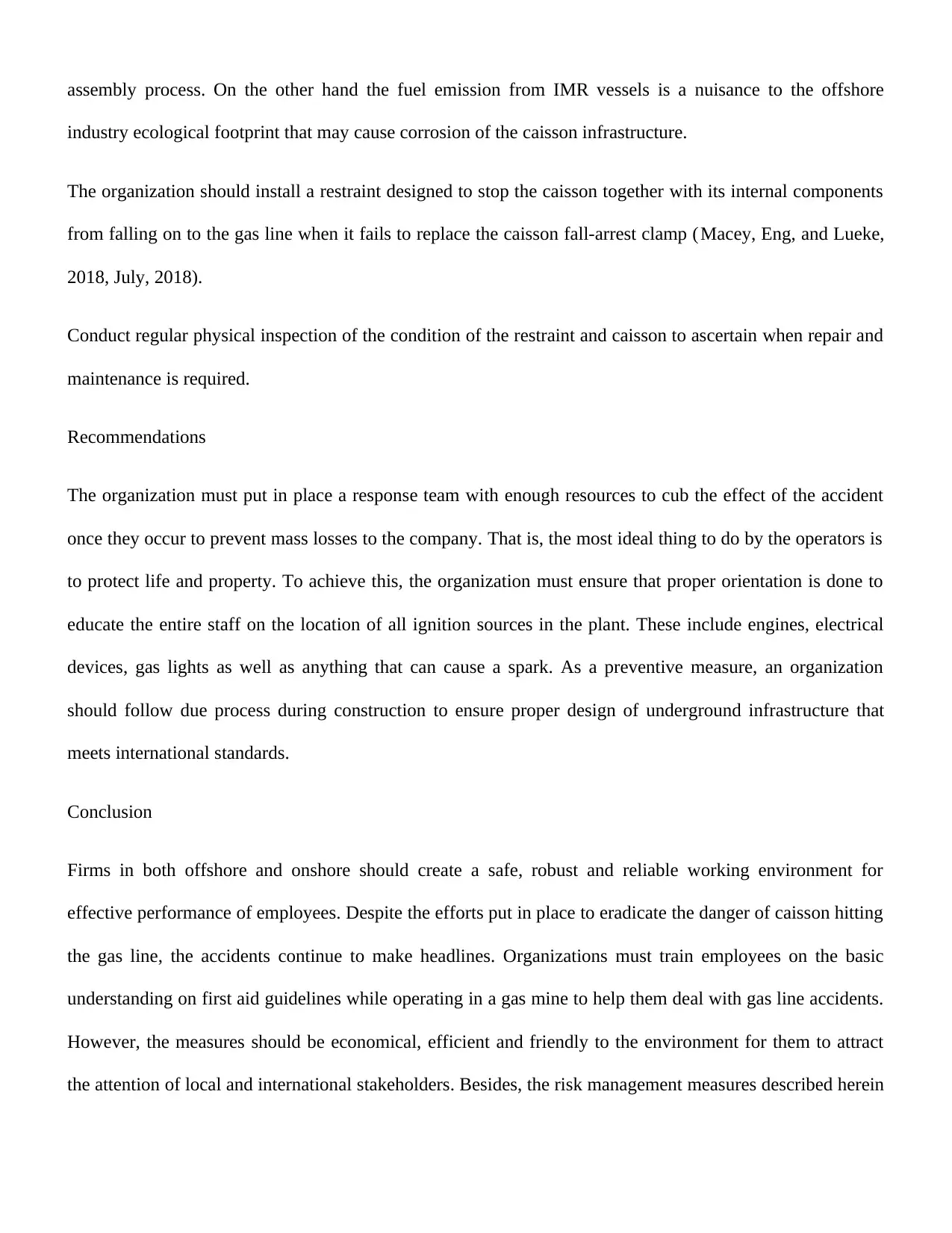
assembly process. On the other hand the fuel emission from IMR vessels is a nuisance to the offshore
industry ecological footprint that may cause corrosion of the caisson infrastructure.
The organization should install a restraint designed to stop the caisson together with its internal components
from falling on to the gas line when it fails to replace the caisson fall-arrest clamp (Macey, Eng, and Lueke,
2018, July, 2018).
Conduct regular physical inspection of the condition of the restraint and caisson to ascertain when repair and
maintenance is required.
Recommendations
The organization must put in place a response team with enough resources to cub the effect of the accident
once they occur to prevent mass losses to the company. That is, the most ideal thing to do by the operators is
to protect life and property. To achieve this, the organization must ensure that proper orientation is done to
educate the entire staff on the location of all ignition sources in the plant. These include engines, electrical
devices, gas lights as well as anything that can cause a spark. As a preventive measure, an organization
should follow due process during construction to ensure proper design of underground infrastructure that
meets international standards.
Conclusion
Firms in both offshore and onshore should create a safe, robust and reliable working environment for
effective performance of employees. Despite the efforts put in place to eradicate the danger of caisson hitting
the gas line, the accidents continue to make headlines. Organizations must train employees on the basic
understanding on first aid guidelines while operating in a gas mine to help them deal with gas line accidents.
However, the measures should be economical, efficient and friendly to the environment for them to attract
the attention of local and international stakeholders. Besides, the risk management measures described herein
industry ecological footprint that may cause corrosion of the caisson infrastructure.
The organization should install a restraint designed to stop the caisson together with its internal components
from falling on to the gas line when it fails to replace the caisson fall-arrest clamp (Macey, Eng, and Lueke,
2018, July, 2018).
Conduct regular physical inspection of the condition of the restraint and caisson to ascertain when repair and
maintenance is required.
Recommendations
The organization must put in place a response team with enough resources to cub the effect of the accident
once they occur to prevent mass losses to the company. That is, the most ideal thing to do by the operators is
to protect life and property. To achieve this, the organization must ensure that proper orientation is done to
educate the entire staff on the location of all ignition sources in the plant. These include engines, electrical
devices, gas lights as well as anything that can cause a spark. As a preventive measure, an organization
should follow due process during construction to ensure proper design of underground infrastructure that
meets international standards.
Conclusion
Firms in both offshore and onshore should create a safe, robust and reliable working environment for
effective performance of employees. Despite the efforts put in place to eradicate the danger of caisson hitting
the gas line, the accidents continue to make headlines. Organizations must train employees on the basic
understanding on first aid guidelines while operating in a gas mine to help them deal with gas line accidents.
However, the measures should be economical, efficient and friendly to the environment for them to attract
the attention of local and international stakeholders. Besides, the risk management measures described herein
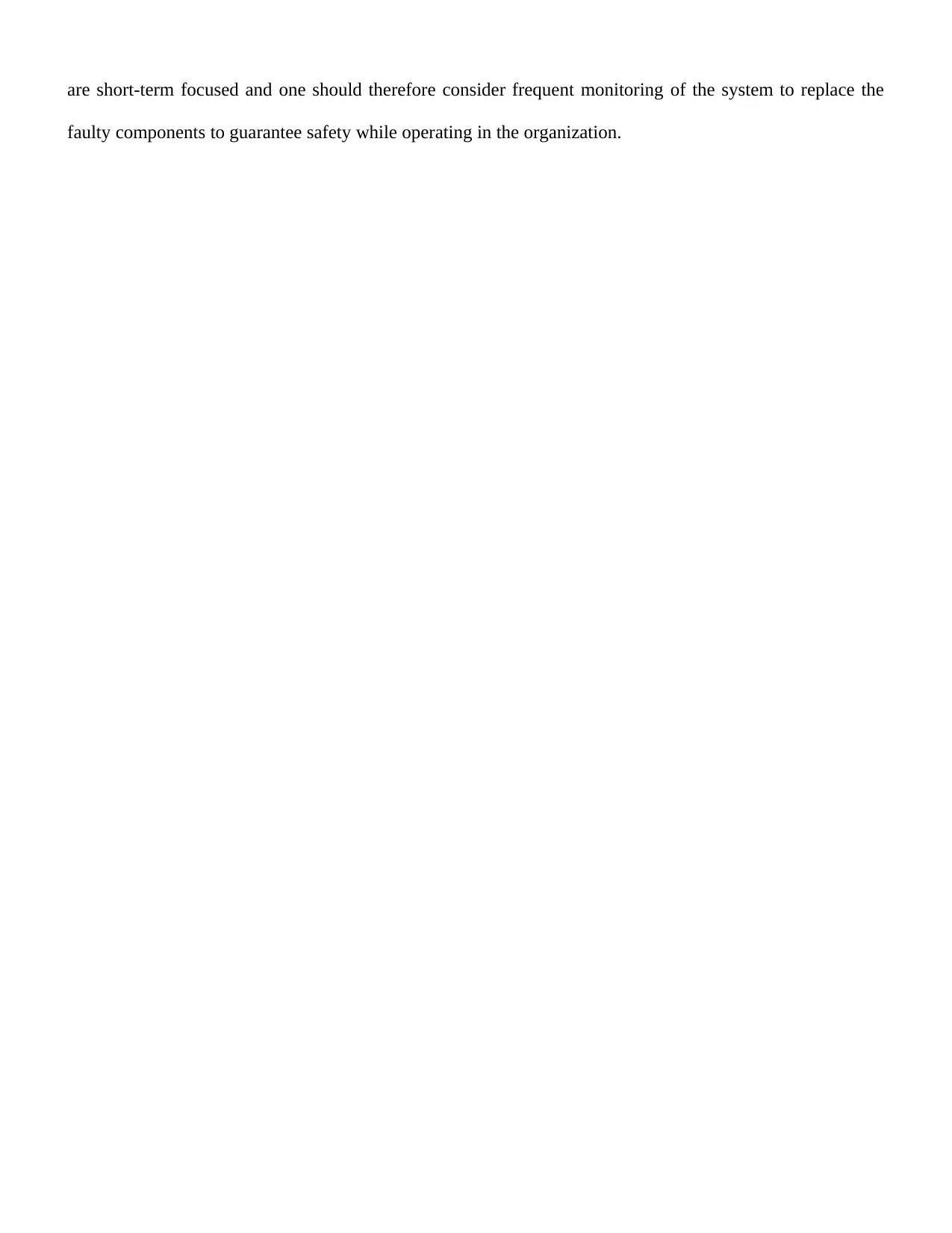
are short-term focused and one should therefore consider frequent monitoring of the system to replace the
faulty components to guarantee safety while operating in the organization.
faulty components to guarantee safety while operating in the organization.
⊘ This is a preview!⊘
Do you want full access?
Subscribe today to unlock all pages.

Trusted by 1+ million students worldwide

TECHNICAL NOTE
Introduction
Operating an integrated system necessitates diagnosis of the nature and scope of failure scenarios for
effective communication of testing and response modalities to reduce risks and salvage costs for the
business. As the system ages, the level of risks also rises and this necessitates more focus and closer
supervision to maintain the technical wellbeing of the company resources in an economical fashion via life
of field. Once installed, any system requires proper monitoring and evaluation to achieve the desired result or
correct mistakes before they escalate to unmanageable levels. Besides, an organization must have a proper
strategy for inspecting the key performance components and reporting the outcome to reduce downtime and
time wastage. As Hofmann, Burke and Zohar (2017) state, a properly conducted inspection of hazardous
processes is a key step towards protecting human life, conserving the environment, maintaining the levels of
production and observing the laws of the land.
1. Failure scenarios
A failure scenario is a recognizable wholesome sequence and combination of likelihood events or conditions
leading to the collapse of a system. It is necessary to identify the failure scenarios because that is the first
step towards eradication of health hazards and minimization of industrial accidents. The following table A
presents some of the failure scenarios that ABCEng Company is likely to face in the production process:
Failure scenarios and measures to be taken to abate further losses and injuries Table A
Componen
t
FAILURE SCENARIOS FOR THE CAISSON REMEDIAL ACTIONS
Inspection
history
Topside
2013-MP1 Exhibited multiple signs of eminent cracks
and elements of corroded walls
Consistent monitoring and
inspection to initiate repair
2005-CVI: A 40% coating breakdown with signs of
corrosion
Proper greasing of movable parts
and painting the caisson hardware
Introduction
Operating an integrated system necessitates diagnosis of the nature and scope of failure scenarios for
effective communication of testing and response modalities to reduce risks and salvage costs for the
business. As the system ages, the level of risks also rises and this necessitates more focus and closer
supervision to maintain the technical wellbeing of the company resources in an economical fashion via life
of field. Once installed, any system requires proper monitoring and evaluation to achieve the desired result or
correct mistakes before they escalate to unmanageable levels. Besides, an organization must have a proper
strategy for inspecting the key performance components and reporting the outcome to reduce downtime and
time wastage. As Hofmann, Burke and Zohar (2017) state, a properly conducted inspection of hazardous
processes is a key step towards protecting human life, conserving the environment, maintaining the levels of
production and observing the laws of the land.
1. Failure scenarios
A failure scenario is a recognizable wholesome sequence and combination of likelihood events or conditions
leading to the collapse of a system. It is necessary to identify the failure scenarios because that is the first
step towards eradication of health hazards and minimization of industrial accidents. The following table A
presents some of the failure scenarios that ABCEng Company is likely to face in the production process:
Failure scenarios and measures to be taken to abate further losses and injuries Table A
Componen
t
FAILURE SCENARIOS FOR THE CAISSON REMEDIAL ACTIONS
Inspection
history
Topside
2013-MP1 Exhibited multiple signs of eminent cracks
and elements of corroded walls
Consistent monitoring and
inspection to initiate repair
2005-CVI: A 40% coating breakdown with signs of
corrosion
Proper greasing of movable parts
and painting the caisson hardware
Paraphrase This Document
Need a fresh take? Get an instant paraphrase of this document with our AI Paraphraser
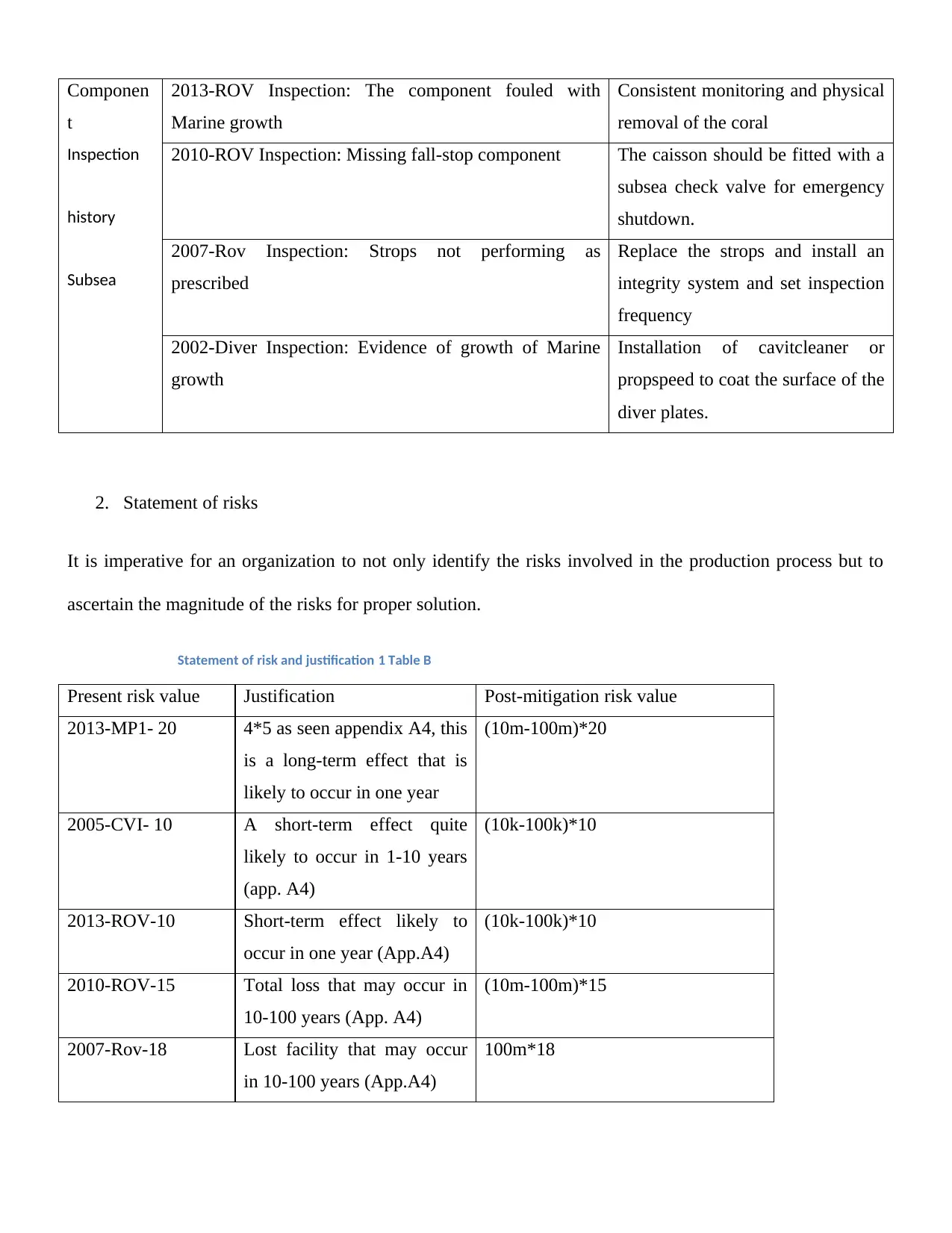
Componen
t
Inspection
history
Subsea
2013-ROV Inspection: The component fouled with
Marine growth
Consistent monitoring and physical
removal of the coral
2010-ROV Inspection: Missing fall-stop component The caisson should be fitted with a
subsea check valve for emergency
shutdown.
2007-Rov Inspection: Strops not performing as
prescribed
Replace the strops and install an
integrity system and set inspection
frequency
2002-Diver Inspection: Evidence of growth of Marine
growth
Installation of cavitcleaner or
propspeed to coat the surface of the
diver plates.
2. Statement of risks
It is imperative for an organization to not only identify the risks involved in the production process but to
ascertain the magnitude of the risks for proper solution.
Statement of risk and justification 1 Table B
Present risk value Justification Post-mitigation risk value
2013-MP1- 20 4*5 as seen appendix A4, this
is a long-term effect that is
likely to occur in one year
(10m-100m)*20
2005-CVI- 10 A short-term effect quite
likely to occur in 1-10 years
(app. A4)
(10k-100k)*10
2013-ROV-10 Short-term effect likely to
occur in one year (App.A4)
(10k-100k)*10
2010-ROV-15 Total loss that may occur in
10-100 years (App. A4)
(10m-100m)*15
2007-Rov-18 Lost facility that may occur
in 10-100 years (App.A4)
100m*18
t
Inspection
history
Subsea
2013-ROV Inspection: The component fouled with
Marine growth
Consistent monitoring and physical
removal of the coral
2010-ROV Inspection: Missing fall-stop component The caisson should be fitted with a
subsea check valve for emergency
shutdown.
2007-Rov Inspection: Strops not performing as
prescribed
Replace the strops and install an
integrity system and set inspection
frequency
2002-Diver Inspection: Evidence of growth of Marine
growth
Installation of cavitcleaner or
propspeed to coat the surface of the
diver plates.
2. Statement of risks
It is imperative for an organization to not only identify the risks involved in the production process but to
ascertain the magnitude of the risks for proper solution.
Statement of risk and justification 1 Table B
Present risk value Justification Post-mitigation risk value
2013-MP1- 20 4*5 as seen appendix A4, this
is a long-term effect that is
likely to occur in one year
(10m-100m)*20
2005-CVI- 10 A short-term effect quite
likely to occur in 1-10 years
(app. A4)
(10k-100k)*10
2013-ROV-10 Short-term effect likely to
occur in one year (App.A4)
(10k-100k)*10
2010-ROV-15 Total loss that may occur in
10-100 years (App. A4)
(10m-100m)*15
2007-Rov-18 Lost facility that may occur
in 10-100 years (App.A4)
100m*18
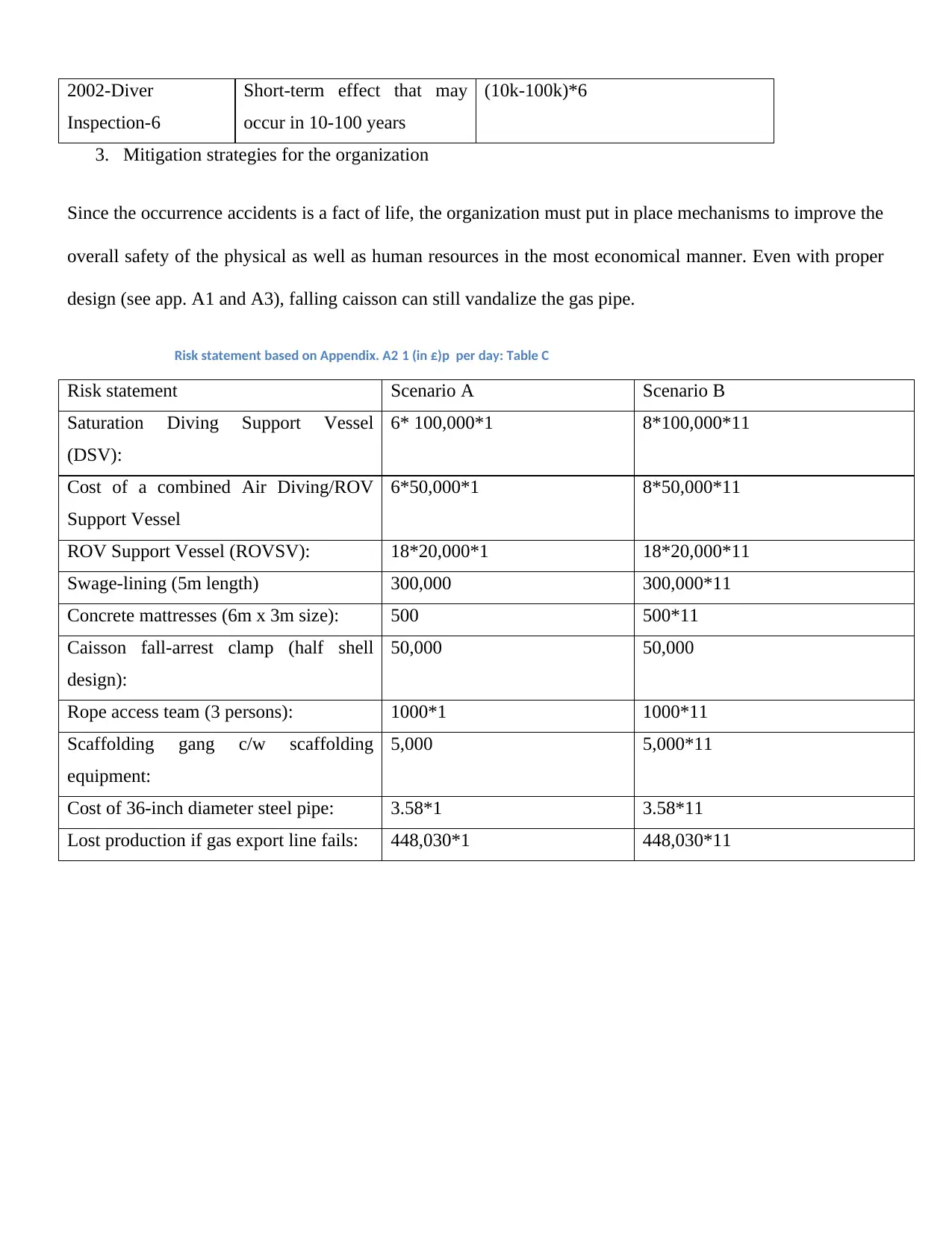
2002-Diver
Inspection-6
Short-term effect that may
occur in 10-100 years
(10k-100k)*6
3. Mitigation strategies for the organization
Since the occurrence accidents is a fact of life, the organization must put in place mechanisms to improve the
overall safety of the physical as well as human resources in the most economical manner. Even with proper
design (see app. A1 and A3), falling caisson can still vandalize the gas pipe.
Risk statement based on Appendix. A2 1 (in £)p per day: Table C
Risk statement Scenario A Scenario B
Saturation Diving Support Vessel
(DSV):
6* 100,000*1 8*100,000*11
Cost of a combined Air Diving/ROV
Support Vessel
6*50,000*1 8*50,000*11
ROV Support Vessel (ROVSV): 18*20,000*1 18*20,000*11
Swage-lining (5m length) 300,000 300,000*11
Concrete mattresses (6m x 3m size): 500 500*11
Caisson fall-arrest clamp (half shell
design):
50,000 50,000
Rope access team (3 persons): 1000*1 1000*11
Scaffolding gang c/w scaffolding
equipment:
5,000 5,000*11
Cost of 36-inch diameter steel pipe: 3.58*1 3.58*11
Lost production if gas export line fails: 448,030*1 448,030*11
Inspection-6
Short-term effect that may
occur in 10-100 years
(10k-100k)*6
3. Mitigation strategies for the organization
Since the occurrence accidents is a fact of life, the organization must put in place mechanisms to improve the
overall safety of the physical as well as human resources in the most economical manner. Even with proper
design (see app. A1 and A3), falling caisson can still vandalize the gas pipe.
Risk statement based on Appendix. A2 1 (in £)p per day: Table C
Risk statement Scenario A Scenario B
Saturation Diving Support Vessel
(DSV):
6* 100,000*1 8*100,000*11
Cost of a combined Air Diving/ROV
Support Vessel
6*50,000*1 8*50,000*11
ROV Support Vessel (ROVSV): 18*20,000*1 18*20,000*11
Swage-lining (5m length) 300,000 300,000*11
Concrete mattresses (6m x 3m size): 500 500*11
Caisson fall-arrest clamp (half shell
design):
50,000 50,000
Rope access team (3 persons): 1000*1 1000*11
Scaffolding gang c/w scaffolding
equipment:
5,000 5,000*11
Cost of 36-inch diameter steel pipe: 3.58*1 3.58*11
Lost production if gas export line fails: 448,030*1 448,030*11
⊘ This is a preview!⊘
Do you want full access?
Subscribe today to unlock all pages.

Trusted by 1+ million students worldwide
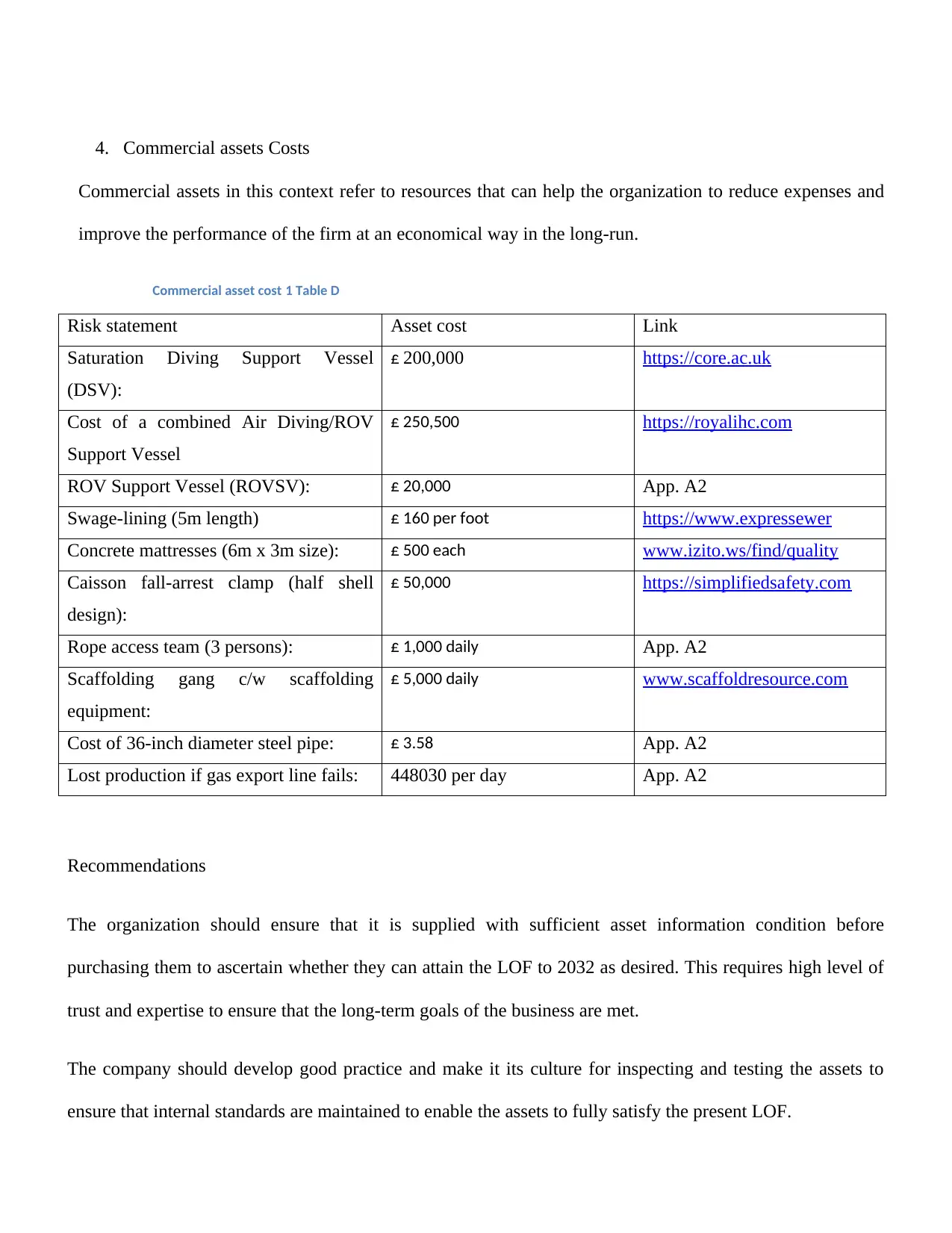
4. Commercial assets Costs
Commercial assets in this context refer to resources that can help the organization to reduce expenses and
improve the performance of the firm at an economical way in the long-run.
Commercial asset cost 1 Table D
Risk statement Asset cost Link
Saturation Diving Support Vessel
(DSV):
£ 200,000 https://core.ac.uk
Cost of a combined Air Diving/ROV
Support Vessel
£ 250,500 https://royalihc.com
ROV Support Vessel (ROVSV): £ 20,000 App. A2
Swage-lining (5m length) £ 160 per foot https://www.expressewer
Concrete mattresses (6m x 3m size): £ 500 each www.izito.ws/find/quality
Caisson fall-arrest clamp (half shell
design):
£ 50,000 https://simplifiedsafety.com
Rope access team (3 persons): £ 1,000 daily App. A2
Scaffolding gang c/w scaffolding
equipment:
£ 5,000 daily www.scaffoldresource.com
Cost of 36-inch diameter steel pipe: £ 3.58 App. A2
Lost production if gas export line fails: 448030 per day App. A2
Recommendations
The organization should ensure that it is supplied with sufficient asset information condition before
purchasing them to ascertain whether they can attain the LOF to 2032 as desired. This requires high level of
trust and expertise to ensure that the long-term goals of the business are met.
The company should develop good practice and make it its culture for inspecting and testing the assets to
ensure that internal standards are maintained to enable the assets to fully satisfy the present LOF.
Commercial assets in this context refer to resources that can help the organization to reduce expenses and
improve the performance of the firm at an economical way in the long-run.
Commercial asset cost 1 Table D
Risk statement Asset cost Link
Saturation Diving Support Vessel
(DSV):
£ 200,000 https://core.ac.uk
Cost of a combined Air Diving/ROV
Support Vessel
£ 250,500 https://royalihc.com
ROV Support Vessel (ROVSV): £ 20,000 App. A2
Swage-lining (5m length) £ 160 per foot https://www.expressewer
Concrete mattresses (6m x 3m size): £ 500 each www.izito.ws/find/quality
Caisson fall-arrest clamp (half shell
design):
£ 50,000 https://simplifiedsafety.com
Rope access team (3 persons): £ 1,000 daily App. A2
Scaffolding gang c/w scaffolding
equipment:
£ 5,000 daily www.scaffoldresource.com
Cost of 36-inch diameter steel pipe: £ 3.58 App. A2
Lost production if gas export line fails: 448030 per day App. A2
Recommendations
The organization should ensure that it is supplied with sufficient asset information condition before
purchasing them to ascertain whether they can attain the LOF to 2032 as desired. This requires high level of
trust and expertise to ensure that the long-term goals of the business are met.
The company should develop good practice and make it its culture for inspecting and testing the assets to
ensure that internal standards are maintained to enable the assets to fully satisfy the present LOF.
Paraphrase This Document
Need a fresh take? Get an instant paraphrase of this document with our AI Paraphraser

The company should invest in research and development to obtain the most current technology for improved
efficiency in the energy industry to meet the vision 2032. This is a long-term goal that requires the input of
all stakeholders due to large capital outlay.
Conclusion
The secret behind the success of most organization lies on the fact that they are capable of diagnosing and
reacting to challenges as they come since they are inevitable in any institution. Companies are encouraged to
develop a framework for testing and monitoring systems on a consistent basis. The main reason why
businesses need a system for modeling failures is because of its appropriateness in determining the action to
take in the early phases of architectural design of the solution. Doing this in time helps an organization’s
staff to improve their understanding of the operational procedures for increased reliability of the system.
Besides, timely realization of a fault line is vital in risk management process since it helps the organization to
save funds that would otherwise be used to replace major components as a result of damages.
efficiency in the energy industry to meet the vision 2032. This is a long-term goal that requires the input of
all stakeholders due to large capital outlay.
Conclusion
The secret behind the success of most organization lies on the fact that they are capable of diagnosing and
reacting to challenges as they come since they are inevitable in any institution. Companies are encouraged to
develop a framework for testing and monitoring systems on a consistent basis. The main reason why
businesses need a system for modeling failures is because of its appropriateness in determining the action to
take in the early phases of architectural design of the solution. Doing this in time helps an organization’s
staff to improve their understanding of the operational procedures for increased reliability of the system.
Besides, timely realization of a fault line is vital in risk management process since it helps the organization to
save funds that would otherwise be used to replace major components as a result of damages.
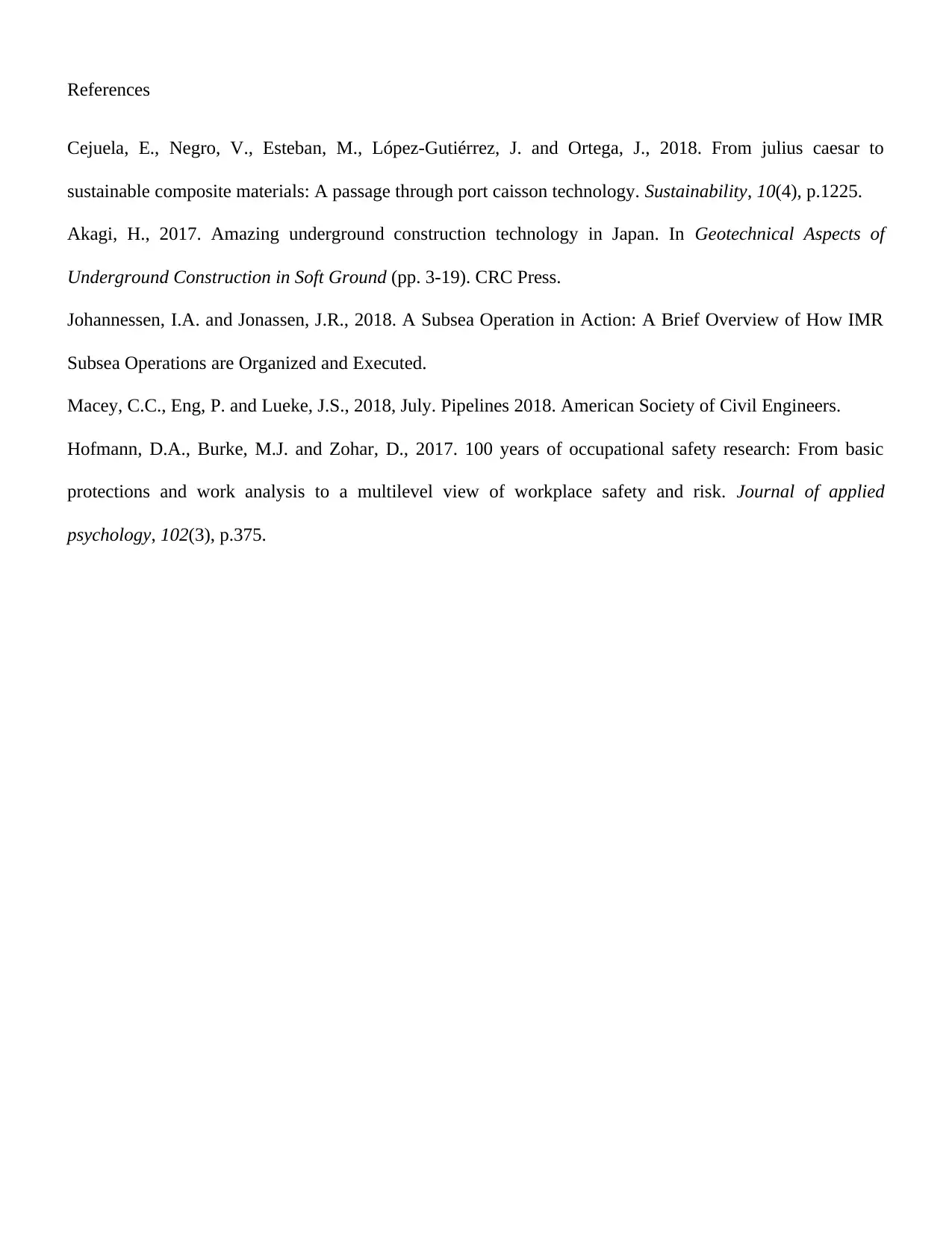
References
Cejuela, E., Negro, V., Esteban, M., López-Gutiérrez, J. and Ortega, J., 2018. From julius caesar to
sustainable composite materials: A passage through port caisson technology. Sustainability, 10(4), p.1225.
Akagi, H., 2017. Amazing underground construction technology in Japan. In Geotechnical Aspects of
Underground Construction in Soft Ground (pp. 3-19). CRC Press.
Johannessen, I.A. and Jonassen, J.R., 2018. A Subsea Operation in Action: A Brief Overview of How IMR
Subsea Operations are Organized and Executed.
Macey, C.C., Eng, P. and Lueke, J.S., 2018, July. Pipelines 2018. American Society of Civil Engineers.
Hofmann, D.A., Burke, M.J. and Zohar, D., 2017. 100 years of occupational safety research: From basic
protections and work analysis to a multilevel view of workplace safety and risk. Journal of applied
psychology, 102(3), p.375.
Cejuela, E., Negro, V., Esteban, M., López-Gutiérrez, J. and Ortega, J., 2018. From julius caesar to
sustainable composite materials: A passage through port caisson technology. Sustainability, 10(4), p.1225.
Akagi, H., 2017. Amazing underground construction technology in Japan. In Geotechnical Aspects of
Underground Construction in Soft Ground (pp. 3-19). CRC Press.
Johannessen, I.A. and Jonassen, J.R., 2018. A Subsea Operation in Action: A Brief Overview of How IMR
Subsea Operations are Organized and Executed.
Macey, C.C., Eng, P. and Lueke, J.S., 2018, July. Pipelines 2018. American Society of Civil Engineers.
Hofmann, D.A., Burke, M.J. and Zohar, D., 2017. 100 years of occupational safety research: From basic
protections and work analysis to a multilevel view of workplace safety and risk. Journal of applied
psychology, 102(3), p.375.
⊘ This is a preview!⊘
Do you want full access?
Subscribe today to unlock all pages.

Trusted by 1+ million students worldwide
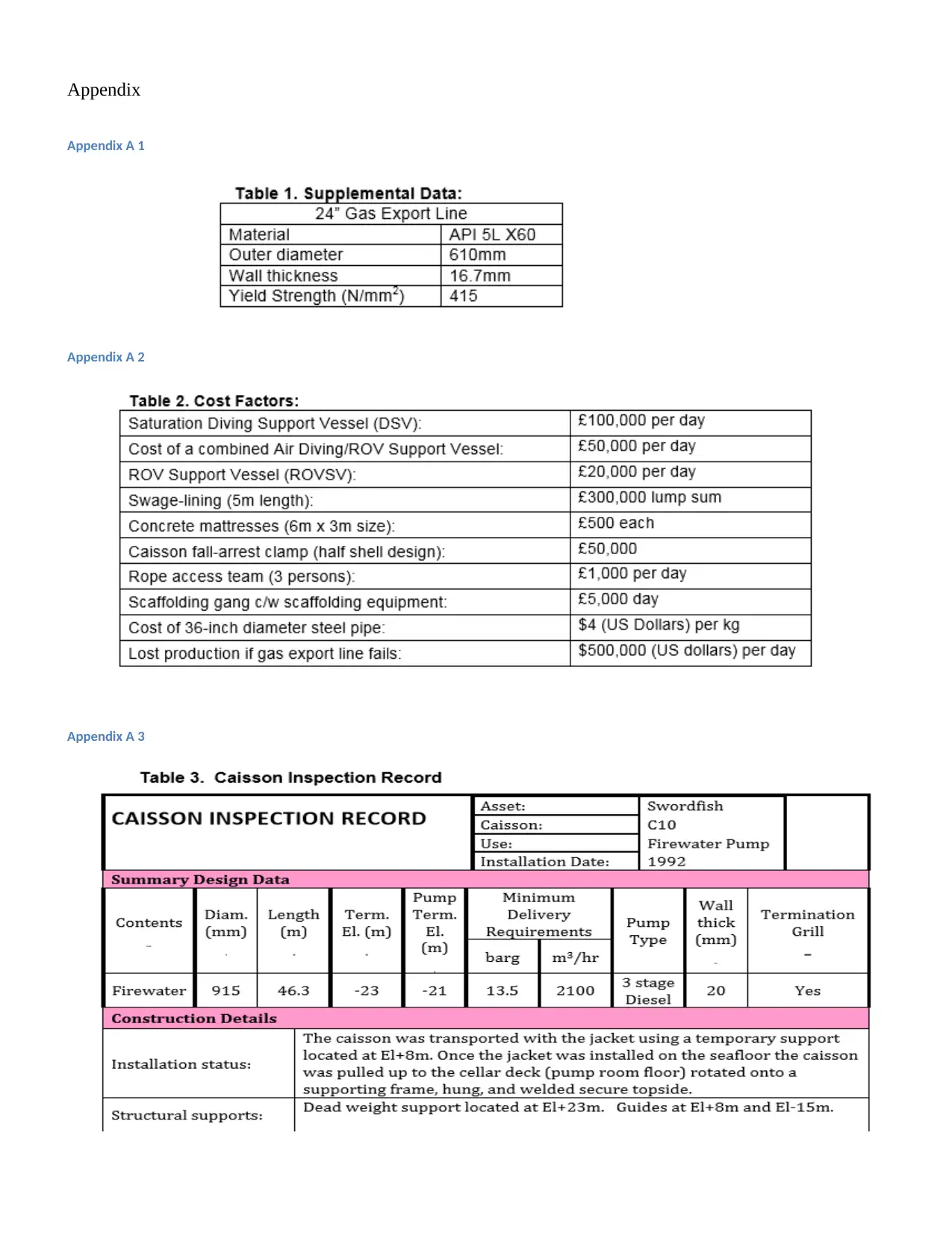
Appendix
Appendix A 1
Appendix A 2
Appendix A 3
Appendix A 1
Appendix A 2
Appendix A 3
Paraphrase This Document
Need a fresh take? Get an instant paraphrase of this document with our AI Paraphraser

Appendix A 4
1 out of 11
Your All-in-One AI-Powered Toolkit for Academic Success.
+13062052269
info@desklib.com
Available 24*7 on WhatsApp / Email
![[object Object]](/_next/static/media/star-bottom.7253800d.svg)
Unlock your academic potential
Copyright © 2020–2025 A2Z Services. All Rights Reserved. Developed and managed by ZUCOL.